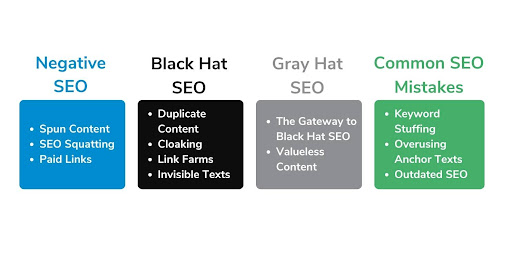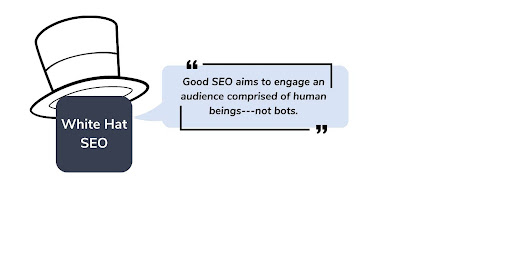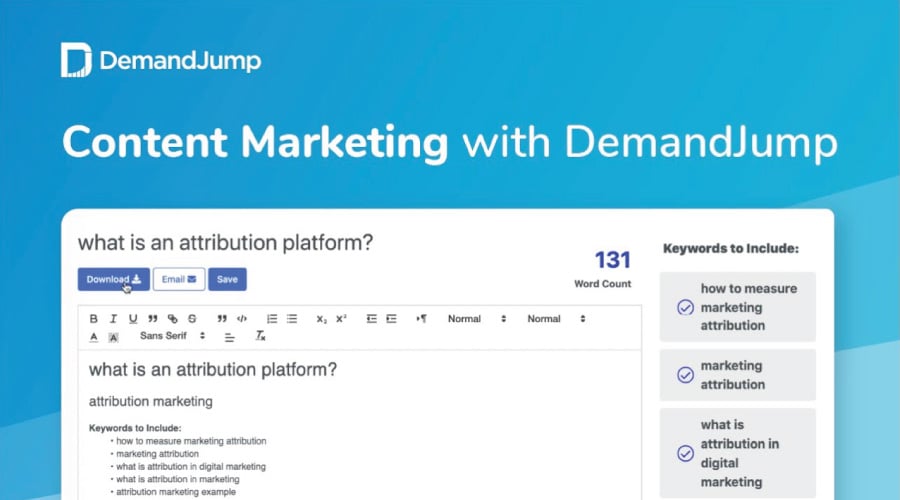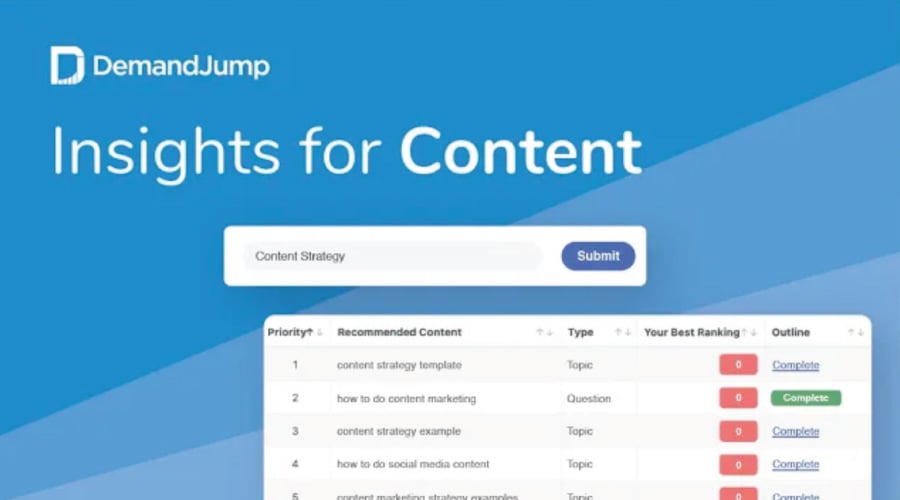“Bad” is a three-letter word with some extremely impactful damage. As we continue on the course that’s turning our entire world digital, SEO strategy sits at the center of this evolution. And where there is seemingly limitless potential to succeed, there’s a fair share of harmful hurdles charading as helping hands. The rapid rise of SEO introduces a whole industry’s worth of advice surrounding what it takes to succeed in this game, but some of that guidance serves as a misdirection more than anything.
However, there’s no need to fear the pitfalls of website optimization when you can properly recognize it and pivot to good SEO principles! In this blog, we’ll help separate the solid techniques from the ones you should avoid. So if you’re looking to spot the wrong from right in SEO practices, then take a little time to review this article loaded with examples of bad SEO in all their shame.
What Is SEO?
Search engine optimization, or SEO, is the process used to increase your rankings on the search engine results pages (SERPs). Whether on-page or off-page, SEO can often determine the exposure your business and its website receives based on how properly (or improperly) you use its given tools and techniques.
Good vs Bad SEO
Like most practices in the digital marketing world, there’s a good side and a bad side to the wide variety of SEO strategies. Good SEO gives your business the proper exposure it needs to succeed and be seen, while bad SEO makes you ultimately invisible to the audience you’re hoping to reach. Let’s take a moment to further analyze both forms!
What Does Good SEO Mean?
Good SEO involves a set of practices for creating website content that is helpful and beneficial to not only your company but your company’s target audience. Notably, it aims to engage an audience comprised of human beings—not bots or search algorithms. Google calls this “people-first content.”
In other words, “good” SEO doesn’t resort to unethical or underhanded practices in order to increase a website’s rankings. For these techniques to be beneficial for both the company’s website and its visitors, the strategies must not attempt to bend, stretch, or even break the rules in place for SERPs.
What Does Bad SEO Mean?
Bad SEO, plainly put, includes SEO techniques and strategies used in all the incorrect manners. It includes all the errors, malpractices, and rule-breaking shortcuts some companies attempt to use as a means to game the system. Bad SEO practices don’t just try to cheat algorithms, they can also turn human readers (potential customers) away.
Just as there are right ways to work with SEO, there are at least as many ill-advised or just plain wrong ways to do it as well. The number of improper practices you could use for SEO may seem limitless and intimidating, but all hope isn’t lost if you know what to look out for along the way! Next, we’ll explore some examples of bad SEO practices, so you can spot them in the wild and avoid them when building out your own strategy.
What Are Bad SEO Practices?
Existing under various names, bad SEO practices are underhanded methods of utilizing SEO to increase your page one rankings. Some of these methods have the potential to backfire, by slowing the speed of your website’s climb to the top or decreasing your rankings overall. As a consequence, you’ll be missing your shot at page one if your writing serves the robots over the people. The most notorious practices we will highlight in this article include:
- Negative SEO
- Black hat and gray hat SEO
- Keyword stuffing
- Common, but often unintentional, SEO mistakes

Without any further hesitation, let’s review all the don'ts of SEO, protecting your future content in the process!
Types of Negative SEO
First and foremost, what is negative SEO? Negative SEO is one form of bad SEO that tap dances on the line between techniques with good intentions versus techniques hoping to bamboozle the audience and the search engines. As you learn more about the different forms of bad SEO, you’ll find that the overarching concept uses several different terms to address itself based on the severity.
Negative SEO is a little bit tricky considering it falls under multiple categories of bad SEO but let’s highlight some of the most notable kinds.
Some of the most common negative SEO tactics include content spinning, SEO squatting, and paid links. Let’s take a closer look at each of these negative SEO techniques.
Content Spinning
A content spinner is a tool that uses an automated system to generate content that is nearly identical to already-existing content. This tool takes an article that’s been written, about any given topic, and spins it to create an article that seems new but isn’t. In actuality, spun content is little more than a plagiarism loophole, technically not breaking enough rules to get the article banned or removed. When using artificial intelligence, such as ChatGPT, it’s difficult to link the spun content to a specific person if they use AI to do the dirty work for them.
As content spinning re-enters the mainstream, look out for these key factors to properly identify an article that’s been spun:
- The words and phrasing don’t sound natural. It’s almost as if the article was written by a robot—because it likely was.
- Automated writing tools are more susceptible to grammatical, punctuational, and spelling errors.
- Tools with systems that check for plagiarism will often read a spun article as plagiarized.
- Recently, Google updated its algorithm to better detect spun content and identify it as spam to prevent it from earning high search engine rankings.
There are several spun content checkers available to review the originality of an article. Although it should be illegal, spun content still exists because there are ways to use an article rewriting tool that can make it ethical. For example, rewriting and spinning your own content is considered fair game because the original piece initially belonged to you. Also, asking for permission to spin someone else’s article removes the shadiness that usually comes with spun content.
SEO Squatting
Often regarded as the watered-down version of domain grabbing, SEO squatting is a negative SEO technique where a company will purchase a domain that expired. Despite its expiration, this domain still holds high authority allowing the company purchasing it to skip the line in building up their domain authority organically.
Paid Links
Established as “link spam” by Google, paid links are yet another shortcut to earning higher rankings for a company’s content. Buying and/or selling links involves:
- Receiving goods or services in exchange for links.
- Receiving money in exchange for links.
- Paying for native advertising where an article includes links with higher ranking credit.
Negative SEO manifests in forms that are either malicious, suspicious, or some combination of the two. The examples listed above are, more or less, light in comparison to the infamous tactics of black hat SEO, which we’ll cover next.
What Is a Black Hat SEO Technique?
While the term “black hat” is commonly known as an alternative for bad SEO, the concept uniquely presents a set of practices in their most malignant forms. Often discussed in a showdown against white hat SEO, black hat SEO techniques can include the following:
Duplicate Content
With its name being rather self-explanatory, duplicate content is simply content that you duplicate and post in several places on one website. Duplicating content on your website messes with Google’s ranking system because its system is suddenly being forced to consider the duplications as separate from the original. The identical pages ultimately appear in addition to the initial piece that it was duplicated from, making less room for fresh content.
Doorway Page
A doorway page (also known as a bridge, gateway, or portal page) is a fake page that is created solely for the purpose of tricking and manipulating search engine spiders into indexing particular sites higher. The page is completely inaccessible to the user and distorts the search engine index by adding results for specific phrases while redirecting the website’s users to a completely different page.
Invisible Texts
Also known as hidden text, invisible text is a much more cunning form of keyword stuffing where you insert keywords in white-colored text on a white background, making it invisible to the naked eye while remaining detectable to search engine spiders.
Link Farming
A link farm is a fake website set to maximize interlinking. This procedure can trick the search engines into detecting relevant inbound links on your website—even though there aren’t any.
Cloaking
This SEO technique takes masking to a whole new level. A web page will ultimately share one version of content or a URL for the search engine spiders to detect, but it will be completely different from the version that pops up in a user’s browser. This is typically done by cloaking the IP address and/or the HTTP header.
Black hat SEO has a lot in common with negative SEO, and the two terms are often used interchangeably. However, negative SEO could occasionally have positive intentions with a negative impact, whereas black hat SEO holds incredibly ill-natured intent from the jump!
Gray Hat SEO
Interestingly enough, negative SEO can often exist as a gray area between black hat and white hat SEO. Think of it as a gateway or slippery slope to black hat SEO. As you could most likely guess, it’s a mixture of white and black with the potential to become entirely malicious when used consistently. Gray hat SEO techniques are also a bit finicky given that no rules or guidelines are actually being broken—yet.

Gray hat SEO is a bit complicated because it can occasionally be a mistake made by the company unintentionally at first. You’re essentially skating on thin ice and if you spend too much time in one spot (choosing to make these “mistakes” over and over) the icy cold water beneath is your deep dive into black hat. Once you’ve stepped into black hat territory, your website and your company’s reputation could potentially fail to recover.
What Are Some Common SEO Mistakes?
In 2023, all of the most common SEO mistakes that businesses make are forms of outdated SEO strategy. Techniques that could’ve worked five years ago aren’t going to easily cheat the system in the present. Many of the practices mentioned previously had little to no guidelines or restrictions when SEO first began to take off.
Now massive search engines such as Google have an established and well-adjusted system set with rules and regulations to maintain the authenticity of the SERPs. These updates lengthen the list of easily-made SEO mistakes. Here’s a list of some common blunders made when you have an outdated or inaccurate understanding of SEO:
- Zero utilization of analytics tools (simply out of lack of knowledge or desire to do so).
- Improper usage of keywords, meta descriptions, and title tags.
- Written content that isn’t obviously geared towards human audiences (AI writing).
- Over-usage of anchor texts.
- Downplaying the significance of mobile-friendly SEO.
- Using literally any technique classified as bad, negative, or black hat SEO (essentially any SEO practice that bends or breaks the rules).
What Is the Main Mistake of SEO that Companies Make?
Amongst the seemingly never-ending list of bad SEO and SEO mistakes, the main error many companies try to mask as an authentic technique is the practice of keyword stuffing.
Keyword stuffing pretty much falls under every single negative example of SEO techniques, but what is it exactly and why should you avoid it?
What Is Keyword Stuffing?
Keyword stuffing is an unethical SEO technique that occurs when a website fills its content and metatags with repetitive keywords. When you attempt to stuff your web page with a particular keyword that you’re hoping to rank for, your content sounds unnatural. It’s as if your target audience isn’t human. It can also feel awkward with the same term randomly shoved into sentences and paragraphs where it doesn’t organically flow.
This tactic is one of many outdated SEO practices that companies still use today despite the bad reputation it will continue to receive.
White Hat SEO
Now that we’ve harped on the wrong ways to utilize SEO, let’s take a brief moment to look at some of the right ways! Here is a quick list of white hat strategies for your convenience:
Keyword Research
Researching various forms of keywords is crucial to a website’s success. Oftentimes, a company will misuse keywords or pick the wrong ones to focus on, creating a major obstacle when trying to increase the page’s rankings. Fortunately, you’ve found your way onto the exact page to offer up all the juicy details on effective keyword research!
DemandJump has an excellent keyword research tool for SEO strategists of all levels to utilize while working to achieve those high website rankings.
Internal Linking
What’s the point in creating fresh content if you can’t link it to relevant, existing content elsewhere on your website? Link building in SEO can be useful if you know how to use it! Make sure to link previous content within your website to new content you added only when it applies.
Quality Content
High-quality content contains fresh keywords surrounding relevant topics on a web page that is updated regularly. If you’re keeping your content up-to-date, your website’s visitors feel motivated to return to the updated pages to see what new information was added to the content.
Sitemap Inclusion
Preventing the loss or misplacement of your website’s information starts with a sitemap. Including a sitemap on your webpage allows your visitors and the search engine spiders to effectively venture through your content with minimal confusion or opportunity to get stuck. Mapping out all the various topics and themes of your content ensures its user-friendliness for your target audience, further encouraging them to return to your page thanks to its organization.
Keyword Placement
After completing your keyword research, you’ll want to take some time placing those relevant terms in all the right spots on your company’s website. This may seem complicated in theory, but it’s really about producing content that sounds as natural as possible. You don’t want to force keywords to fit where they don’t belong and it’s critical to keep in mind that you’re writing for an audience of human readers—not robots.

Where Can You Learn How To Fix SEO Issues? DemandJump!
There are so many right ways to take advantage of SEO techniques. Identifying all the less-acceptable methods can get you on track to displaying a website full of fresh content with positive SEO.
If you need a place to get started on your journey to fixing any existing SEO-related issues you might be facing, look no further! Here at DemandJump, we can help you avoid the trial and error that comes along with the learning process for proper optimization. So, let’s not waste any more time on the errors made in the past because your website deserves effective SEO strategies to bring the audience to your content. Give us a try today!












